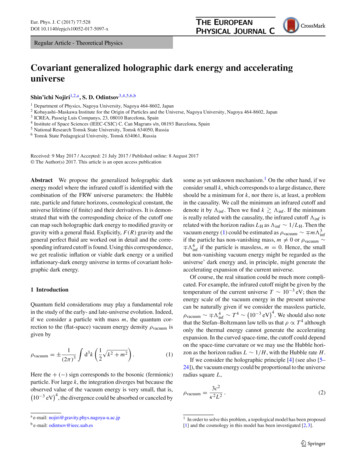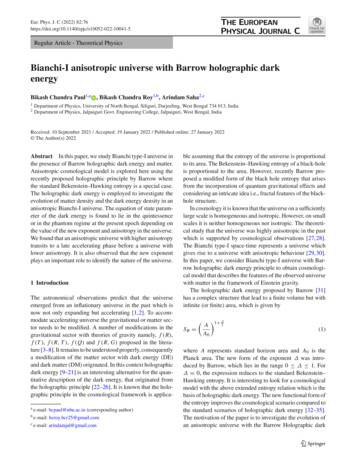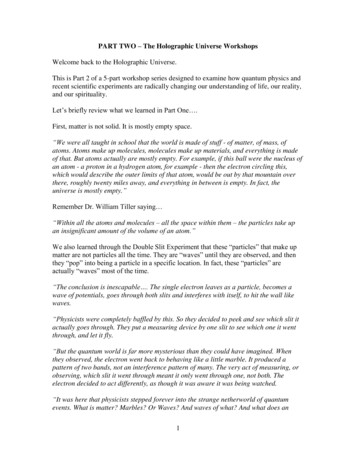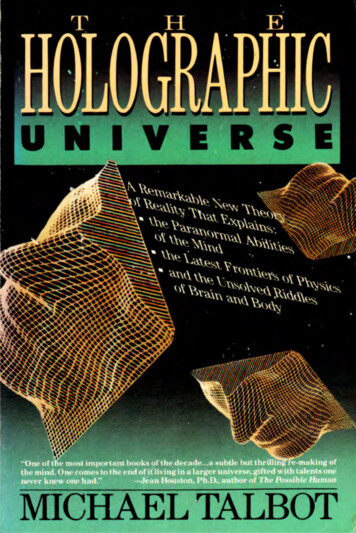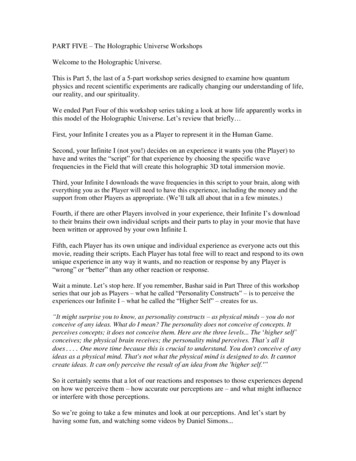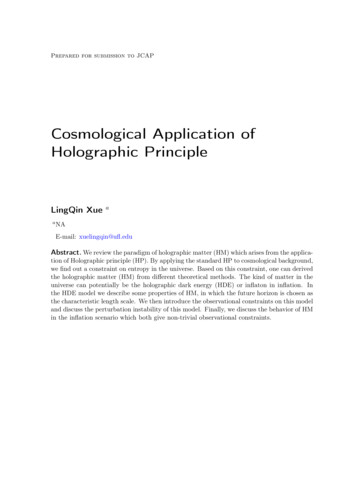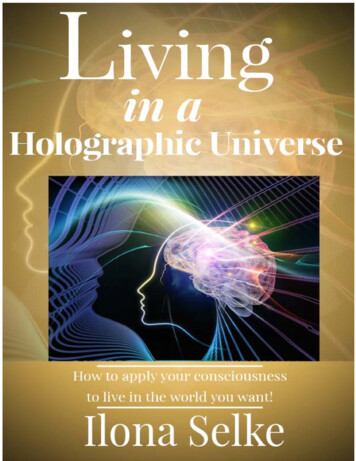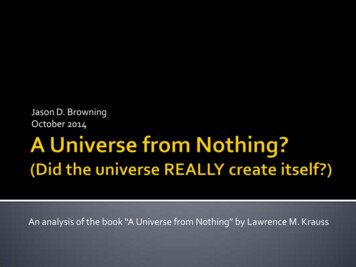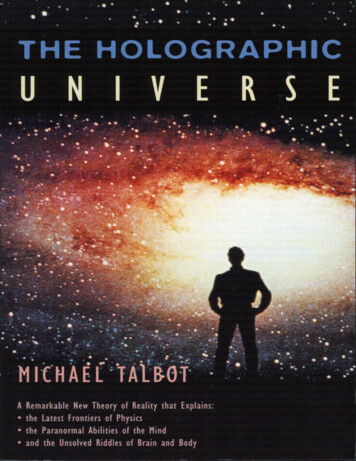
Transcription
Michael Talbot was born in Grand Rapids, Michigan, in 1953.He is the author of Mysticism and the New Physics, Beyondthe Quantum and Your Past Lives: A ReincarnationHandbook, as well as three novels.
THEHOLOGRAPHICUNIVERSEMICHAEL TALBOTHarperCollinsPublishes
HarperCollinsPublishes77-85 Fulham Palace Road,Hammersmith, London W6 8JBThis paperback edition 199612Previously published by Grafton Books 1991First published in Great Britain byHarperCollinsPublishesCopyright Michael Talbot 1991The Author asserts the moral right tobe identified as the author of this workISBN 0 586 091718Printed and bound in Great Britain byClays Lid, St Ives picAll rights reserved. No part of this publication may bereproduced, stored in a retrieval system, or transmitted,in any form or by any means, electronic, mechanical,photocopying, recording or otherwise, without the priorpermission of the publishers.This book is sold subject to the condition that it shall not,by way of trade or otherwise, be lent, re-sold, hired out orotherwise circulated without the publisher's prior consentin any form of binding or cover other than that in which itis published and without a similar condition including thiscondition being imposed on the subsequent purchaser.
For Alexandra, Chad, Ryan,Larry Joe, and Shawn,with love
The new data are of such far-reaching relevance thatthey could revolutionize our understanding of thehuman psyche, of psychopathology, and of thetherapeutic process. Some of the observationstranscend in their significance the framework ofpsychology and psychiatry and represent a seriouschallenge to the current Newtonian-Cartesianparadigm of Western science. They could changedrastically our image of human nature, of cultureand history, and of reality.—Dr. Stanislav Grof onholographic phenomena inThe Adventure of Self-Discovery
ContentsAcknowledgmentsIntroductionPART I: A REMARKABLE NEW VIEW OF REALITY1. The Brain as Hologram2. The Cosmos as HologramPART II: MIND AND BODY3. The Holographic Model and Psychology4. I Sing the Body Holographic5. A Pocketful of Miracles6. Seeing HolographicallyPART III: SPACE AND TIME7. Time Out of Mind8. Traveling in the Superhologram9. Return to the DreamtimeNotesIndex
AcknowledgmentsWriting is always a collaborative effort and many people have contributedto the production of this book in various ways. It is not possible to namethem all, but a few who deserve special mention include:David Bohm, Ph.D., and Karl Pribram, Ph.D., who were generous withboth their time and their ideas, and without whose work this book wouldnot have been written.Barbara Brennan, M.S., Larry Dossey, M.D., Brenda Dunne, Ph.D.,Elizabeth W. Fenske, Ph.D., Gordon Globus, Jim Gordon, Stanislav Grof,M.D., Francine Howland, M.D., Valerie Hunt, Ph.D., Robert Jahn, Ph.D.,Ronald Wong Jue, Ph.D., Mary Orser, F. David Peat, Ph.D., ElizabethRauscher, Ph.D., Beatrice Rich, Peter M. Rojcewicz, Ph.D., AbnerShimony, PhD., Bernie S. Siegel, M.D., T.M. Srinivasan, M.D., WhitleyStrieber, Russell Targ, William A. Tiller, Ph.D., Montague Ullman, M.D.,Lyall Watson, Ph.D., Joel L. Whitton, M.D., Ph.D., Fred Alan Wolf, Ph.D.,and Richard Zarro, who were also all generous with their time and ideas.Carol Ann Dryer, for her friendship, insight, and support, and forunending generosity when it comes to sharing her profound talent.Kenneth Ring, Ph.D., for hours of fascinating conversation and forintroducing me to the writings of Henry Corbin.Stanley Krippner, Ph.D., for taking the time to call me or drop me a notewhenever he came across any new leads on the holographic idea.Terry Oleson, Ph.D., for his time and for kindly allowing me to use hisdiagram of the “little man in the ear.”Michael Grosso, Ph.D., for thought-provoking conversation and forhelping me track down several obscure reference works on miracles.Brendan O'Regan of the Institute of Noetic Sciences, for his importantcontributions to the subject of miracles and for helping me track downinformation on the same.My longtime friend Peter Brunjes, Ph.D., for using his universityconnections to help me obtain several difficult-to-find reference works.Judith Hooper, for loaning me numerous books and articles from herown extensive collection of materials on the holographic idea.
Susan Cowles, M.S., of the Museum of Holography in New York forhelping me search out illustrations for the book.Kerry Brace, for sharing his thoughts on the holographic idea as itapplies to Hindu thinking, and from whose writings I have borrowed theidea of using the hologram of Princess Leia from the movie Star Wars toopen the book.Marilyn Ferguson, the founder of the Brain/Mind Bulletin, who was oneof the first writers to recognize and write about the importance of theholographic theory, and who also was generous with her time and thought.The observant reader will notice that my summary of the view of theuniverse that arises when one considers Bohm and Pribram's conclusions intandem, at the end of Chapter Two, is actually just a slight rephrasing of thewords Ferguson uses to summarize the same sentiment in her bestsellingbook The Aquarian Conspiracy. My inability to come up with a differentand better way to summarize the holographic idea should be viewed as atestament to Ferguson's clarity and succinctness as a writer.The staff at the American Society for Psychical Research for assistancein tracking down references, resources, and the names of pertinentindividuals.Martha Visser and Sharon Schuyler for their help in researching thebook.Ross Wetzsteon of the Village Voice, who asked me to write the articlethat started it all.Claire Zion of Simon & Schuster, who first suggested that I write abook on the holographic idea.Lucy Kroll and Barbara Hogenson for being the best agents possible.Lawrence P. Ashmead of HarperCollins for believing in the book, andJohn Michel for his gentle and insightful editing.If there is anyone that I have inadvertently left out, please forgive me.To all, both named and unnamed, who have helped me give birth to thisbook, my heartfelt thanks.
IntroductionIn the movie Star Wars, Luke Skywalker's adventure begins when a beamof light shoots out of the robot Artoo Detoo and projects a miniature threedimensional image of Princess Leia. Luke watches spellbound as theghostly sculpture of light begs for someone named Obi-wan Kenobi tocome to her assistance. The image is a hologram, a three-dimensionalpicture made with the aid of a laser, and the technological magic required tomake such images is remarkable. But what is even more astounding is thatsome scientists are beginning to believe the universe itself is a kind of gianthologram, a splendidly detailed illusion no more or less real than the imageof Princess Leia that starts Luke on his quest.Put another way, there is evidence to suggest that our world andeverything in it—from snowflakes to maple trees to falling stars andspinning electrons—are also only ghostly images, projections from a levelof reality so beyond our own it is literally beyond both space and time.The main architects of this astonishing idea are two of the world's mosteminent thinkers: University of London physicist David Bohm, a protege ofEinstein's and one of the world's most respected quantum physicists; andKarl Pribram, a neurophysiologist at Stanford University and author of theclassic neuropsychological textbook Languages of the Brain. Intriguingly,Bohm and Pribram arrived at their conclusions independently and whileworking from two very different directions. Bohm became convinced of theuniverse's holographic nature only after years of dissatisfaction withstandard theories’ inability to explain all of the phenomena encountered inquantum physics. Pribram became convinced because of the failure ofstandard theories of the brain to explain various neurophysiological puzzles.However, after arriving at their views, Bohm and Pribram quicklyrealized the holographic model explained a number of other mysteries aswell, including the apparent inability of any theory, no matter howcomprehensive, ever to account for all the phenomena encountered in
nature; the ability of individuals with hearing in only one ear to determinethe direction from which a sound originates; and our ability to recognize theface of someone we have not seen for many years even if that person haschanged considerably in the interim.But the most staggering thing about the holographic model was that itsuddenly made sense of a wide range of phenomena so elusive theygenerally have been categorized outside the province of scientificunderstanding. These include telepathy, precognition, mystical feelings ofoneness with the universe, and even psychokinesis, or the ability of themind to move physical objects without anyone touching them.Indeed, it quickly became apparent to the ever growing number ofscientists who came to embrace the holographic model that it helpedexplain virtually all paranormal and mystical experiences, and in the lasthalf-dozen years or so it has continued to galvanize researchers and shedlight on an increasing number of previously inexplicable phenomena. Forexample: In 1980 University of Connecticut psychologist Dr. KennethRing proposed that near-death experiences could be explainedby the holographic model. Ring, who is president of theInternational Association for Near-Death Studies, believessuch experiences, as well as death itself, are really nothingmore than the shifting of a person's consciousness from onelevel of the hologram of reality to another. In 1985 Dr. Stanislav Grof, chief of psychiatric research atthe Maryland Psychiatric Research Center and an assistantprofessor of psychiatry at the Johns Hopkins UniversitySchool of Medicine, published a book in which he concludedthat existing neurophysiological models of the brain areinadequate and only a holographic model can explain suchthings as archetypal experiences, encounters with thecollective unconscious, and other unusual phenomenaexperienced during altered states of consciousness. At the 1987 annual meeting of the Association for the Studyof Dreams held in Washington, D.C., physicist Fred Alan Wolfdelivered a talk in which he asserted that the holographicmodel explains lucid dreams (unusually vivid dreams in which
the dreamer realizes he or she is awake). Wolf believes suchdreams are actually visits to parallel realities, and theholographic model will ultimately allow us to develop a“physics of consciousness” which will enable us to begin toexplore more fully these other-dimensional levels of existence. In his 1987 book entitled Synchronicity: The Bridge BetweenMatter and Mind, Dr. F. David Peat, a physicist at Queen'sUniversity in Canada, asserted that synchronicities(coincidences that are so unusual and so psychologicallymeaningful they don't seem to be the result of chance alone)can be explained by the holographic model. Peat believes suchcoincidences are actually “flaws in the fabric of reality.” Theyreveal that our thought processes are much more intimatelyconnected to the physical world than has been hithertosuspected.These are only a few of the thought-provoking ideas that will beexplored in this book. Many of these ideas are extremely controversial.Indeed, the holographic model itself is highly controversial and is by nomeans accepted by a majority of scientists. Nonetheless, and as we shallsee, many important and impressive thinkers do support it and believe itmay be the most accurate picture of reality we have to date.The holographic model has also received some dramatic experimentalsupport. In the field of neurophysiology numerous studies havecorroborated Pribram's various predictions about the holographic nature ofmemory and perception. Similarly, in 1982 a landmark experimentperformed by a research team led by physicist Alain Aspect at the Instituteof Theoretical and Applied Optics, in Paris, demonstrated that the web ofsubatomic particles that compose our physical universe—the very fabric ofreality itself—possesses what appears to be an undeniable “holographic”property. These findings will also be discussed in the book.In addition to the experimental evidence, several other things addweight to the holographic hypothesis. Perhaps the most importantconsiderations are the character and achievements of the two men whooriginated the idea. Early in their careers, and before the holographic modelwas even a glimmer in their thoughts, each amassed accomplishments thatwould inspire most researchers to spend the rest of their academic lives
resting on their laurels. In the 1940s Pribram did pioneering work on thelimbic system, a region of the brain involved in emotions and behavior.Bohm's work in plasma physics in the 1950s is also considered landmark.But even more significantly, each has distinguished himself in anotherway. It is a way even the most accomplished men and women can seldomcall their own, for it is measured not by mere intelligence or even talent It ismeasured by courage, the tremendous resolve it takes to stand up for one'sconvictions even in the face of overwhelming opposition. While he was agraduate student, Bohm did doctoral work with Robert Oppenheimer. Later,in 1951, when Oppenheimer came under the perilous scrutiny of SenatorJoseph McCarthy's Committee on Un-American Activities, Bohm wascalled to testify against him and refused. As a result he lost his job atPrinceton and never again taught in the United States, moving first to Braziland then to London.Early in his career Pribram faced a similar test of mettle. In 1935 aPortuguese neurologist named Egas Moniz devised what he believed wasthe perfect treatment for mental illness. He discovered that by boring intoan individual's skull with a surgical pick and severing the prefrontal cortexfrom the rest of the brain he could make the most troublesome patientsdocile. He called the procedure a prefrontal lobotomy, and by the 1940s ithad become such a popular medical technique that Moniz was awarded theNobel Prize. In the 1950s the procedure's popularity continued and itbecame a tool, like the McCarthy hearings, to stamp out culturalundesirables. So accepted was its use for this purpose that the surgeonWalter Freeman, the most outspoken advocate for the procedure in theUnited States, wrote unashamedly that lobotomies “made good Americancitizens” out of society's misfits, “schizophrenics, homosexuals, andradicals.”During this time Pribram came on the medical scene. However, unlikemany of his peers, Pribram felt it was wrong to tamper so recklessly withthe brain of another. So deep were his convictions that while working as ayoung neurosurgeon in Jacksonville, Florida, he opposed the acceptedmedical wisdom of the day and refused to allow any lobotomies to beperformed in the ward he was overseeing. Later at Yale he maintained hiscontroversial stance, and his then radical views very nearly lost him his job.Bohm and Pribram's commitment to stand up for what they believe in,regardless of the consequences, is also evident in the holographic model. As
we shall see, placing their not inconsiderable reputations behind such acontroversial idea is not the easiest path either could have taken. Both theircourage and the vision they have demonstrated in the past again add weightto the holographic idea.One final piece of evidence in favor of the holographic model is theparanormal itself. This is no small point, for in the last several decades aremarkable body of evidence has accrued suggesting that our currentunderstanding of reality, the solid and comforting sticks-and-stones pictureof the world we all learned about in high-school science class, is wrong.Because these findings cannot be explained by any of our standardscientific models, science has in the main ignored them. However, thevolume of evidence has reached the point where this is no longer a tenablesituation.To give just one example, in 1987, physicist Robert G. Jahn and clinicalpsychologist Brenda J. Dunne, both at Princeton University, announced thatafter a decade of rigorous experimentation by their Princeton EngineeringAnomalies Research Laboratory, they had accumulated unequivocalevidence that the mind can psychically interact with physical reality. Morespecifically, Jahn and Dunne found that through mental concentration alone,human beings are able to affect the way certain kinds of machines operate.This is an astounding finding and one that cannot be accounted for in termsof our standard picture of reality.It can be explained by the holographic view, however. Conversely,because paranormal events cannot be accounted for by our current scientificunderstandings, they cry out for a new way of looking at the universe, anew scientific paradigm. In addition to showing how the holographic modelcan account for the paranormal, the book will also examine how mountingevidence in favor of the paranormal in turn actually seems to necessitate theexistence of such a model.The fact that the paranormal cannot be explained by our currentscientific worldview is only one of the reasons it remains so controversial.Another is that psychic functioning is often very difficult to pin down in thelab, and this has caused many scientists to conclude it therefore does notexist. This apparent elusiveness will also be discussed in the book.An even more important reason is that contrary to what many of us havecome to believe, science is not prejudice-free. I first learned this a numberof years ago when I asked a well-known physicist what he thought about a
particular parapsychological experiment. The physicist (who had areputation for being skeptical of the paranormal) looked at me and withgreat authority said the results revealed “no evidence of any psychicfunctioning whatsoever.” I had not yet seen the results, but because Irespected the physicist's intelligence and reputation, I accepted hisjudgment without question. Later when I examined the results for myself, Iwas stunned to discover the experiment had produced very strikingevidence of psychic ability. I realized then that even well-known scientistscan possess biases and blind spots.Unfortunately this is a situation that occurs often in the investigation ofthe paranormal. In a recent article in American Psychologist, Yalepsychologist Irvin L. Child examined how a well-known series of ESPdream experiments conducted at the Maimonides Medical Center inBrooklyn, New York, had been treated by the scientific establishmentDespite the dramatic evidence supportive of ESP uncovered by theexperimenters, Child found their work had been almost completely ignoredby the scientific community. Even more distressing, in the handful ofscientific publications that had bothered to comment on the experiments, hefound the research had been so “severely distorted” its importance wascompletely obscured.1How is this possible? One reason is science is not always as objective aswe would like to believe. We view scientists with a bit of awe, and whenthey tell us something we are convinced it must be true. We forget they areonly human and subject to the same religious, philosophical, and culturalprejudices as the rest of us. This is unfortunate, for as this book will show,there is a great deal of evidence that the universe encompasses considerablymore than our current worldview allows.But why is science so resistant to the paranormal in particular? This is amore difficult question. In commenting on the resistance he experienced tohis own unorthodox views on health, Yale surgeon Dr. Bernie S. Siegel,author of the best-selling book Love, Medicine, and Miracles, asserts that itis because people are addicted to their beliefs. Siegel says this is why whenyou try to change someone's belief they act like an addictThere seems to be a good deal of truth to Siegel's observation, whichperhaps is why so many of civilization's greatest insights and advances haveat first been greeted with such passionate denial. We are addicted to ourbeliefs and we do act like addicts when someone tries to wrest from us the
powerful opium of our dogmas. And since Western science has devotedseveral centuries to not believing in the paranormal, it is not going tosurrender its addiction lightly.I am lucky. I have always known there was more to the world than isgenerally accepted. I grew up in a psychic family, and from an early age Iexperienced firsthand many of the phenomena that will be talked about inthis book. Occasionally, and when it is relevant to the topic being discussed,I will relate a few of my own experiences. Although they can only beviewed as anecdotal evidence, for me they have provided the mostcompelling proof of all that we live in a universe we are only just beginningto fathom, and I include them because of the insight they offer.Lastly, because the holographic concept is still very much an idea in themaking and is a mosaic of many different points of view and pieces ofevidence, some have argued that it should not be called a model or theoryuntil these disparate points of view are integrated into a more unified whole.As a result, some researchers refer to the ideas as the holographicparadigm. Others prefer holographic analogy, holographic metaphor, andso on. In this book and for the sake of diversity I have employed all of theseexpressions, including holographic model and holographic theory, but donot mean to imply that the holographic idea has achieved the status of amodel or theory in the strictest sense of these terms.In this same vein it is important to note that although Bohm and Pribramare the originators of the holographic idea, they do not embrace ail of theviews and conclusions put forward in this book. Rather, this is a book thatlooks not only at Bohm and Pribram's theories, but at the ideas andconclusions of numerous researchers who have been influenced by theholographic model and who have interpreted it in their own sometimescontroversial ways.Throughout this book I also discuss various ideas from quantumphysics, the branch of physics that studies subatomic particles (electrons,protons, and so on). Because I have written on this subject before, I amaware that some people are intimidated by the term quantum physics andare afraid they will not be able to understand its concepts. My experiencehas taught me that even those who do not know any mathematics are able tounderstand the kinds of ideas from physics that are touched upon in thisbook. You do not even need a background in science. All you need is anopen mind if you happen to glance at a page and see a scientific term you
do not know. I have kept such terms down to a minimum, and on thoseoccasions when it was necessary to use one, I always explain it beforecontinuing on with the text.So don't be afraid. Once you have overcome your “fear of the water,” Ithink you'll find swimming among quantum physics’ strange andfascinating ideas much easier than you thought. I think you'll also find thatpondering a few of these ideas might even change the way you look at theworld. In fact, it is my hope that the ideas contained in the followingchapters will change the way you look at the world. It is with this humbledesire that I offer this book.
PART IA REMARKABLENEW VIEWOF REALITYSit down before fact like a little child, and be prepared to give up everypreconceived notion, follow humbly wherever and to whatever abyssNature leads, or you shall learn nothing.—T. H. Huxley
1The Brain as HologramIt isn't that the world of appearances is wrong; it isn't that there aren't objectsout there, at one level of reality. It's that if you penetrate through and look atthe universe with a holographic system, you arrive at a different view, adifferent reality. And that other reality can explain things that have hithertoremained inexplicable scientifically: paranormal phenomena, synchronicities,the apparently meaningful coincidence of events.—Karl Pribramin an interview in Psychology TodayThe puzzle that first started Pribram on the road to formulating hisholographic model was the question of how and where memories are storedin the brain. In the early 1940s, when he first became interested in thismystery, it was generally believed that memories were localized in the brain.Each memory a person had, such as the memory of the last time you sawyour grandmother, or the memory of the fragrance of a gardenia you sniffedwhen you were sixteen, was believed to have a specific location somewherein the brain cells. Such memory traces were called engrams, and although noone knew what an engram was made of—whether it was a neuron or perhapseven a special kind of molecule—most scientists were confident it was only amatter of time before one would be found. There were reasons for thisconfidence. Research conducted by Canadian neurosurgeon Wilder Penfieldin the 1920s had offered convincing evidence that specific memories did havespecific locations in the brain. One of the most unusual features of the brainis that the object itself doesn't sense pain directly. As long as the scalp andskull have been deadened with a local anesthetic, surgery can be performedon the brain of a fully conscious person without causing any pain.In a series of landmark experiments, Penfield used this fact to hisadvantage. While operating on the brains of epileptics, he would electricallystimulate various areas of their brain cells. To his amazement he found thatwhen he stimulated the temporal lobes (the region of the brain behind thetemples) of one of his fully conscious patients, they reexperienced memoriesof past episodes from their lives in vivid detail. One man suddenly relived a
conversation he had had with friends in South Africa; a boy heard his mothertalking on the telephone and after several touches from Penfield's electrodewas able to repeat her entire conversation; a woman found herself in herkitchen and could hear her son playing outside. Even when Penfield tried tomislead his patients by telling them he was stimulating a different area whenhe was not, he found that when he touched the same spot it always evokedthe same memory.In his book The Mystery of the Mind, published in 1975, just shortlybefore his death, he wrote, “It was evident at once that these were not dreams.They were electrical activations of the sequential record of consciousness, arecord that had been laid down during the patient's earlier experience. Thepatient ‘re-lived’ all that he had been aware of in that earlier period of time asin a moving-picture ‘flashback.’”1From his research Penfield concluded that everything we have everexperienced is recorded in our brain, from every stranger's face we haveglanced at in a crowd to every spider web we gazed at as a child. He reasonedthat this was why memories of so many insignificant events kept cropping upin his sampling. If our memory is a complete record of even the mostmundane of our day-to-day experiences, it is reasonable to assume thatdipping randomly into such a massive chronicle would produce a good dealof trifling information.As a young neurosurgery resident, Pribram had no reason to doubtPenfield's engram theory. But then something happened that was to changehis thinking forever. In 1946 he went to work with the greatneuropsychologist Karl Lashley at the Yerkes Laboratory of Primate Biology,then in Orange Park, Florida. For over thirty years Lashley had been involvedin his own ongoing search for the elusive mechanisms responsible formemory, and there Pribram was able to witness the fruits of Lashley's laborsfirsthand. What was startling was that not only had Lashley failed to produceany evidence of the engram, but his research actually seemed to pull the rugout from under all of Penfield's findings.What Lashley had done was to train rats to perform a variety of tasks,such as run a maze. Then he surgically removed various portions of theirbrains and retested them. His aim was literally to cutout the area of the rats’brains containing the memory of their maze-running ability. To his surprisehe found that no matter what portion of their brains he cut out, he could noteradicate their memories. Often the rats’ motor skills were impaired and they
stumbled clumsily through the mazes, but even with massive portions of theirbrains removed, their memories remained stubbornly intact.For Pribram these were incredible findings. If memories possessedspecific locations in the brain in the same way that books possess specificlocations on library shelves, why didn't Lashley's surgical plunderings haveany effect on them? For Pribram the only answer seemed to be that memorieswere not localized at specific brain sites, but were somehow spread out ordistributed throughout the brain as a whole. The problem was that he knew ofno mechanism or process that could account for such a state of affairs.Lashley was even less certain and later wrote, “I sometimes feel, inreviewing the evidence on the localization of the memory trace, that thenecessary conclusion is that learning just is not possible at all. Nevertheless,in spite of such evidence against it, learning does sometimes occur.”2 In 1948Pribram was offered a position at Yale, and before leaving he helped write upthirty years of Lashley's monumental research.The BreakthroughAt Yale, Pribram continued to ponder the idea that memories were distributedthroughout the brain, and the more he thought about it the more convinced hebecame. After all, patients who had had portions of their brains removed formedical reasons never suffered the loss of specific memories. Removal of alarge section of the brain might cause a patient's memory to become generallyhazy, but no one ever came out of surgery with any selective memory loss.Similarly, individuals who had received head injuries in car collisions andother accidents never forgot half of their family, or half of a novel they hadread. Even removal of sections of the temporal lobes, the
The holographic model has also received some dramatic experimental support. In the field of neurophysiology numerous studies have corroborated Pribram's various predictions about the holographic nature of memory and perception. Similarly, in 1982 a landmark experiment performed by a research team led by physicist Alain Aspect at the Institute


